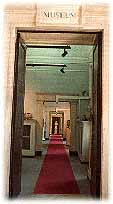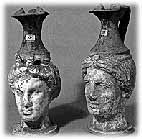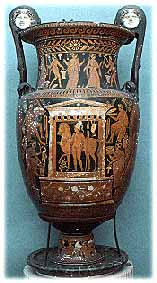 he Museum is composed of four rooms located in the Jatta palace in Piazza G. Bovio, 35. he Museum is composed of four rooms located in the Jatta palace in Piazza G. Bovio, 35.
The collection’s arrangement is utoday the one that G. Jatta Junior disposed in the middle of the XIXth century.
|
|
 In the first room there are the painted and architectural earthenware, geometrically decorated vases, black varnished vases Egnazia’s type and some rhytà, pride of the museum. In the first room there are the painted and architectural earthenware, geometrically decorated vases, black varnished vases Egnazia’s type and some rhytà, pride of the museum. |
|
Polychrome oinochoais
(first hellenic age)
|
|
 To be noticed two archaic native kraters with figured decoration on greek models and of oriental inspiration, two polychrome oinochoai whose lower parts are shaped as Pan and feminine’s heads. To be noticed two archaic native kraters with figured decoration on greek models and of oriental inspiration, two polychrome oinochoai whose lower parts are shaped as Pan and feminine’s heads. |
|
|
In the middle of the second room, on a column, we find the biggest vase in the Museum, an apulian mask krater ascribed to the Baltimore Painter and full of mythological figures and scenes; in the second shelf, an apulian bell krater representing Heracles in front of Athena.
|
|
Apulian mask krater
(320 b.c.)
|
|
 |
|